![]()
![]()
![]()
Use LEFT and RIGHT arrow keys to navigate between flashcards;
Use UP and DOWN arrow keys to flip the card;
H to show hint;
A reads text to speech;
126 Cards in this Set
- Front
- Back
|
1 family in order Didelphimorphia
|
Didelphidae
|
|
|
2 families in Soricomorpha
|
Soricidae & Talpidae
|
|
|
8 families in Carnivora
|
Canidae, Ursidae, Otariidae, Phocidae, Procyonidae, Mustelidae, Mephitidae, Felidae
|
|
|
8 species in family Soricidae
|
Sorex bendirii, S. monticolus, S. pacificus, S. palustris, S. preblei, S. sonomae, S. trowbridgii, S. vagrans
Sorex-soricis-the shrew mouse |
|
|
Sorex bendirii-common name
|
Pacific water or marsh shrew
|
|
|
Sorex monticolus-common name
|
montane or dusky shrew
monticolus-mountain dwelling |
|
|
Sorex pacificus-common name
|
Pacific shrew
|
|
|
Sorex palustris-common name
|
water shrew
palustris-marshy |
|
|
Sorex preblei-common name
|
Preble's shrew
|
|
|
Sorex sonomae-common name
|
fog shrew
|
|
|
Sorex trowbridgii-common name
|
Trowbridge's shrew
|
|
|
4 species in family Talpidae
|
Neurotrichus gibbsii, Scapanus latimanus, S. orarius, S. townsendii
|
|
|
Neurotrichus gibbsii-common name
|
shrew-mole
neos-new oura-tail trichos-hair new hairy-tail |
|
|
Scapanus latimanus-common name
|
broad-footed mole
scapane-spade/hoe latus-broad manus-hand |
|
|
Scapanus orarius-common name
|
coast mole
scapane-spade/hoe orarius-coasting/used along the coast |
|
|
Scapanus townsendii-common name
|
Townsend's mole
|
|
|
4 species in family Canidae
|
Canis latrans, C. lupus, Urocyon cinereoargenteus, V. vulpes
|
|
|
Canis latrans-common name
|
coyote
latrans-a barker |
|
|
Canis lupus-common name
|
gray wolf
|
|
|
Urocyon cinereoargenteus-common name
|
gray fox
oura-tail kuon-dog cinereus-ash-colored argentus-silvery |
|
|
Vulpes vulpes-common name
|
red fox
|
|
|
1 species in family Ursidae
|
Ursus americanus
|
|
|
Ursus americanus-common name
|
black bear
|
|
|
3 species in family Otariidae
|
Callorhinus ursinus, Eumetopias jubatus, Zalophus californianus
|
|
|
Callorhinus ursinus-common name
|
northern fur seal
kallos-beauty rhinos-skin/hide |
|
|
Eumetopias jubatus-common name
|
northern (Stellar's) sea lion
eu-well/typical metapion-forehead jubatus-having a mane |
|
|
Zalophus californicus-common name
|
California sea lion
za-intensive lopho-crest-high sagittal crest |
|
|
2 species in family Phocidae
|
Mirounga angustirostris, Phoca vitulina
|
|
|
Mirounga angustirostris-common name
|
northern elephant seal
mirounga-seal angustus-narrow crest |
|
|
Phoca vitulina-common name
|
harbor seal
vitula-calf |
|
|
3 families in Artiodactyla
|
Cervidae, Antilocapridae, Bovidae
|
|
|
2 species in family Procyonidae
|
Bassariscus astutus, Procyon lotor
|
|
|
9 species in family Mustelidae
|
Martes americana, M. pennanti, Mustela erminea, M. frenata, M. vison, Gulo gulo, Taxidea taxus, Lutra canadensis, Enhydra lutris
mustela-weasel |
|
|
2 species in family Mephitidae
|
Spilogale gracilis, Mephitis mephitis
|
|
|
2 species in family Felidae
|
Puma concolor, Lynx rufus
|
|
|
3 species in family Cervidae
|
Cervus elephus, Odocoileus hemionus, Odocoileus virginianus
|
|
|
1 species in family Antilocapridae
|
Antilocapra americana
|
|
|
3 species in family Bovidae
|
Bos bison, Oreamnos americanus, Ovis canadensis
|
|
|
Bassariscus astutus-common name
|
ringtail
bassara-fox astutus-fox |
|
|
Procyon lotor-common name
|
raccoon
pro-before cyon-dog lotor-to wash |
|
|
Martes americana-common name
|
American marten
martes-marten |
|
|
Martes pennanti-common name
|
fisher
|
|
|
Mustela erminea-common name
|
ermine
|
|
|
Mustela frenata-common name
|
long-tailed weasel
|
|
|
Mustela vison-common name
|
mink
vison-American mink |
|
|
Gulo gulo-common name
|
wolverine
gulo-throat (as in gluttonous) |
|
|
Taxidea taxus-common name
|
American badger
|
|
|
Lutra canadensis-common name
|
river otter
lutra-otter |
|
|
Enhydra lutris-common name
|
sea otter
enhydra-otter |
|
|
Spilogale gracilis-common name
|
western spotted skunk
silos-spot gale-marten cat or weasel |
|
|
Mephitis mephitis-common name
|
striped skunk
mephitis-noxious smell |
|
|
Puma concolor-common name
|
mountain lion
|
|
|
Lynx rufus-common name
|
bobcat
|
|
|
Cervus elaphus-common name
|
elk
|
|
|
Odocoileus hemionus-common name
|
black-tailed and mule deer
oidous-tooth koilos-hollow hemionus-mule |
|
|
Odocoileus virginianus-common name
|
white-tailed deer
|
|
|
Antilocapra americana-common name
|
pronghorn
|
|
|
Bos bison-common name
|
bison
bos-cow bison-wild ox |
|
|
Oreamnos americanus-common name
|
mountain goat
oros-mountain amnos-lamb |
|
|
Ovis canadensis-common name
|
mountain (bighorn) sheep
|
|
|
Canid skull characteristics
|
elongated rostrum, well developed carnassial teeth
size best character- |
|
|
Urocyon cinereoargenteus skull characteristics
|
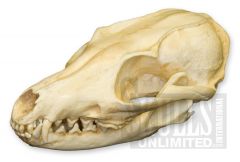
2-3 mm temporal ridges forming lyre pattern (U-shaped) on roof of skull, top of post orbital processes convex, 4 mandibular processes
|
|
|
Vulpes vulpes skull characteristics
|
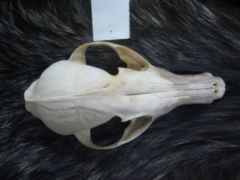
<1mm temporal ridges forming V-or U-shaped pattern on roof of skull, top of post orbital processes convex
|
|
|
Canis latrans skull
|
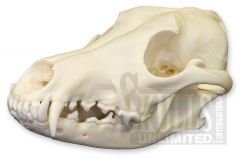
upper canines longer than mental foramen in lower jaw, top of post orbital process convex, lobed incisors
|
|
|
Canis lupus skull
|
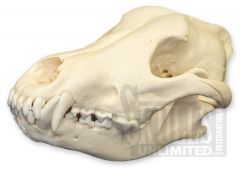
upper canines shorter than mental foramen, top of post orbital process convex
|
|
|
Procyon lotor skull
|
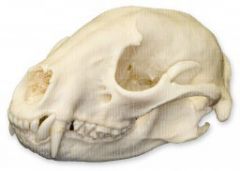
broad rostrum, palate extends far posteriorly, small post orbital processes, ridges on upper palate parallel to teeth
|
|
|
Bassariscus astutus skull
|
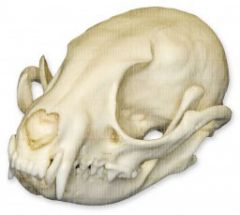
narrow rostrum, palate does not extend posteriorly beyond teeth, well developed connecting post orbital processes, large eye sockets, <1mm temporal ridges forming U-shape, ridges on upper palate perpendicular to teeth, not flattened
|
|
|
Didelphis virginiana skull characteristics
|
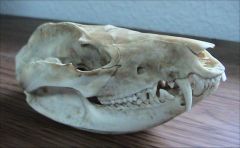
incisors 5/4
older individuals have prominent and rugose sagittal and lambdoidal crests |
|
|
didelphis virginiana skin characteristics
|
cat-sized, pointy nose, unfurred black leathery ears with white edges, naked scaly prehensile tail, wooly underfur with coarse guard hair
|
|
|
Talpidae characters
|
no ears, single faceted condyloid, 1 projection at end of nose, non-pigmented teeth, weak zygomata, I1 unicuspid and of equal length and width in ventral view
|
|
|
soricidae characters
|
small ears, double faceted condyloid, 2 projections at end of nose, pigmented teeth, no zygomata, I1 bicuspid and longer than wide in ventral view
|
|
|
Neurotrichus gibbsii skull characters
|
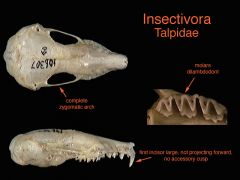
bi-lobed basal projections on M1 & M2
thin only slightly bowed zygomata |
|
|
Neurotrichus gibbsii skin characters
|
forehand longer than wide
smaller (<130mm) tail sparsely hairy and tufted black pelage |
|
|
Scapanus sp. skull characters
|
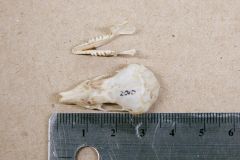
simple basal projections on M1 & M2
|
|
|
Scapanus latimanus
|
total length >130mm
pelage lighter grayish with coppery wash U5 & U6 appressed (crowded) sometimes only on 1 side |
|
|
Scapanus orarius
|
pelage blackish to purplish black (often with indistinct white spots)
U5 & U6 evenly spaced total length <200mm |
|
|
Scapanus townsendii
|
pelage blackish to purplish black (often with indistinct white spots)
U5 & U6 evenly spaced total length >200mm |
|
|
Canis latrans skin characters
|
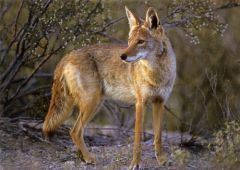
grayish, buff, pinkish, cinnamon, or brownish or combo of those colors, often overlain with blackish tipped hairs on muzzle, feet and dorsum
lips and eyelids black with white borders of fur |
|
|
Canis lupus skin characters
|
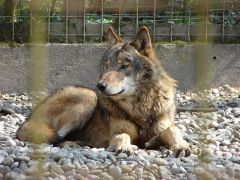
pelage long over body and tail but short on legs and face, predominant color usually gray but legs, flanks and venter are sometimes yellowish or light brownish overlain by long, black guard hairs on dorsum, tail and mane
|
|
|
Urocyon cinereoargenteus
|
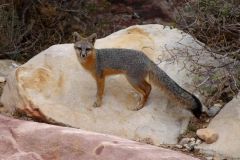
pelage grizzled gray with stiff middorsal hairs with long black tips that extend onto the tail as a black mane, guard hairs are banded white (tips), gray and black
throat, venter and inside of legs are white cinnamon-rufous border to white throat extends onto flanks and underside of tail |
|
|
Vulpes vulpes
|
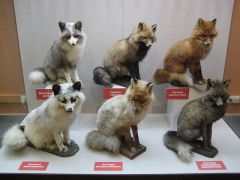
red, silver and cross color phases
red-deep rusty dorsally grading to rusty grizzled with white posteriorly and to a lighter rust along the sides, gray under fur, white belly, back of ears and front of legs black our pelt has brown guard hairs with white tips |
|
|
Ursus americanus skull
|

face convex, massive, prominent frontal ridges, heavy zygomata, strong rugose sagittal and lamboidal crests, cheek teeth flattish
|
|
|
Callorhinus ursinus skull
|
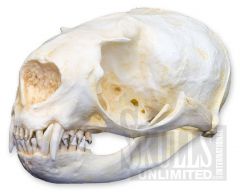
pinniped, rostrum pointy, palate deeply notched, homodont dentition, triangular postorbital process, 6 post-canine teeth
|
|
|
Zalophus californianus skull
|
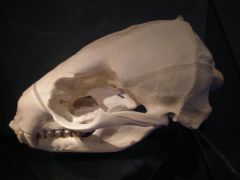
pinniped, narrow, palate lacking deep notch, postorbital processes rounded on anterior edge, homodont, P4 & M1 separated by less space than the length of a cheek tooth
|
|
|
Eumetopias jubatus skull
|

pinniped, massive, postorbital processes squarish, homodont, P4 & M1 separated by more space than the length of a cheek tooth, long narrow palate extending far posteriorly to M1
|
|
|
Callorhinus ursinus description
|
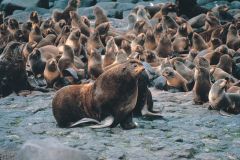
pinniped, soft under fur, smallest member of family in OR, extreme sexual dimorphism, proportionately large flippers, coarse guard hairs with dense under fur, grayish-brown dorsally and reddish-brown ventrally
|
|
|
Eumetopias jubatus description
|
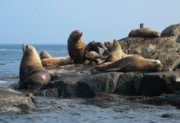
pinniped, largest member of family, sexual dimorphism, small rear flippers, light buff to reddish brown with darker ventral, appears white underwater, nose pad and flippers black
|
|
|
Zalophus californianus description
|
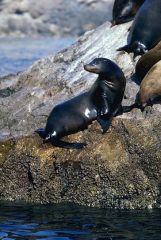
pinniped, mid-sized, considerable sexual dimorphism, short coarse pelage without under fur, chocolate brown, appears black underwater
|
|
|
Mirounga angustirostris description
|
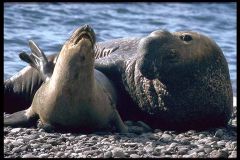
largest pinniped carnivore along north Pacific coast, considerable sexual dimorphism, elongated tubular proboscis, uniform coloration, reduced pelage consisting of stiff hairs with little to no under fur
|
|
|
Phoca vitulina description
|
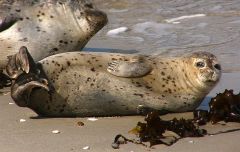
less sexual dimorphism than other pinnipeds, large rounded head with large eyes, short limbs, long overhairs with short under hairs, gray or brownish gray with numerous small spot of black that may form splotches
|
|
|
Bassariscus astutus description
|
elongate body and tail of approzimately equal length, tail has 8 dark bands alternating with 7 buffy bands becoming darker posteriorly, dorsum buff overlain with blackish or dark brownish guard hairs, belly is whitish or light buff, feet furred except pads
|
|
|
Procyon lotor description
|
moderately large, heavily furred, dark brownish-black eye mask, tail has 5-7 dark rings separated by light ray or tan rings, feet naked, hind legs longer than front makes rump taller than head when walking
|
|
|
Martes sp. skulls
|
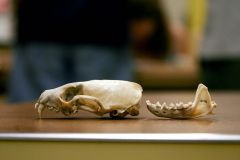
low profile, 38 teeth, saggital crest extends <10mm beyond lambdoidal crest, well developed carnassial teeth, palate extends posteriorly well beyond cheekteeth, M1 has enormous medial lobe
|
|
|
Martes americana description
|
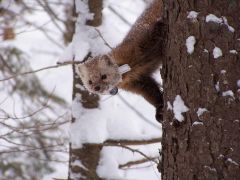
weasel-like with long body and pointy face, short legs, feet including pads furred, luxuriant pelage of dense underfur and sparse guard hairs, golden-brown to dark brown on feet and tail, head lighter than, throat and chest splotched with orange or yellow, small dark eye stripe extends upward from medial corner of each eye
|
|
|
Martes pennanti description
|
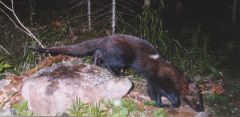
stockier than weasels, head pointy, body elongate and legs short, feet furred except for pads, pelage long except on face, long guard hairs, dark brown grading to black on rump and legs, tail black, face neck and shoulders grizzled, belly brown and irregularly splotched with white or cream in genital or chest regions
|
|
|
Mustela sp. skulls
|
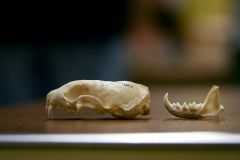
<=34 teeth, flattened, small rounded-pointy postorbital processes,
|
|
|
Mustela vison skin description
|
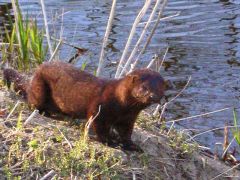
largest of genus, more or less uniformly dark brownish-black occasionally with small white spots on belly, body elongate and cylindrical, short stout legs, tail bushy and about 1/2 body length, feet furred except pads, pointy nose, dark grayish underfur with luxuriant guard hairs, color darkens toward tip of tail
|
|
|
Mustela erminea skin description
|
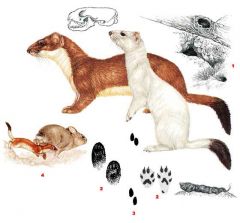
smallest of genus, long cylindrical neck and body, short legs, short tail (<44%bl), brown back white-to-yellow belly in summer and some all white in winter, whole foot furry in winter and furry except pads in summer, tip of tail always black
|
|
|
Mustela frenata skin description
|

medium of genus, elongate cylindrical body, long tail (>44%bl), brown back, yellow-to-orangish belly, white chin, sometimes white in winter, always black tip of tail,
|
|
|
Gulo gulo description
|

largest terrestrial mustelid, blackish brown with pale stripe along sides from head or shoulders to base of tail, sometimes lighter face mask, bearlike appearance, relatively short legs and droopy tail
|
|
|
Taxidea taxus skull
|
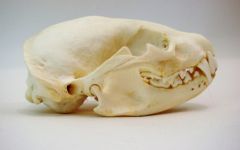
34 teeth, M1 & P4 triangular, nearly equilaterally triangular post orbital processes, stout zygomata as wide or wider than braincase, palate far beyond M1, occipital and lamboidal crests
|
|
|
Taxidea taxus skin description
|
medium sized powerful mustelid adapted for digging, flattened body, short stout legs, forefeet partially webbed, long curved claws, long shaggy pelage mottled grayis blending to light tannish or whitish on belly, white stripe from nose pad to shoulders, face black with white splotches surrounding black spot on cheeks, feet blackish, tail short
|
|
|
Lutra canadensis skull
|
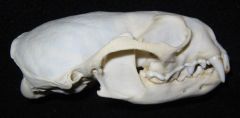
36 teeth, anterior edge of coronoid straight and at right angle to toothrow, somewhat flattened, short broad rostrum, pointy post orbital processes,
|
|
|
Lutra canadensis skin description
|
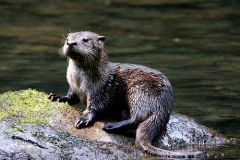
pelage dark brown with whitish lower jaw and lighter brown to tan belly, hind toes webbed, short legs, aquatic and terrestrial modifications
|
|
|
Enhydra lutris skull
|

32 teeth, molariform teeth strongly modified for crushing, anterior edge of coronoid process curved posteriorly and usually angled posteriorly >=15 degrees, large, left side bigger, low sagittal and lambdoidal crests, sometimes purple from sea urchin diet, two lower incisors scoop shaped and protruding
|
|
|
Enhydra lutra description
|

largest mustelid, large rounded head, short front legs, mitten like front paws, much of hind legs enclosed, tail flattened and not tapered, dark brown with head neck and shoulders lighter and somewhat grizzled in older adults
|
|
|
Mephitis mephitis skull
|
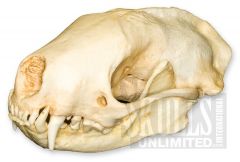
sides of posterior margin of skull slightly concave viewed dorsally, rostrum lower than forehead, inferior margin of mandible with distinct step at angle of jaw, heavy and angular, widest near posterior attachment of zygomatic arch, convex forehead, squarish posterior margin, sagittal and lambdoidal crests prominent in older individuals, lambdoidal margin overhangs base of skull, palate nearly even with end of toothrow, minute post orbital processes
|
|
|
Spilogale gracilis skull
|
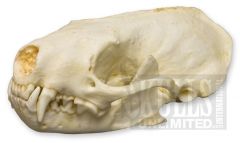
flattened with rostrum nearly level with forehead, posterior margin convex, small post orbital processes, palate nearly even with back of toothrow
|
|
|
Mephitis mephitis description
|
house cat sized, pointy head, black with thin white stripe from nose pad to forehead, spot on pate, two white stripes extending posteriorly on dorsum
|
|
|
Spilogale gracilis description
|
smaller and more weasel like than striped skunk, black with three white spots on head, 4-6 white body stripes often broken into series of spots, distal 1/3-1/2 tail white
|
|
|
Puma concolor skull
|
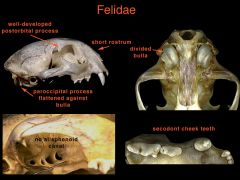
incisors chisel like & in straight line, P4 & m1 highly modified for shearing, short rostrum, large & massive, large sagittal and lambdoidal crests, prominent nearly connected postorbital processes, stout zygomata,
|
|
|
Lynx rufus skull
|
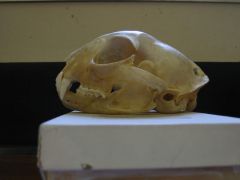
incisors chisel like & in straight line, P4 & m1 strongly modified for shearing, short rostrum, medium-small, slight sagittal crest, moderate rugose lambdoidal crest, prominent and nearly connected post orbital processes
|
|
|
Puma concolor description
|
tips of ears lacking prominent tufts, tail >50% length of head and body, dense soft dorsal fur tawny to slate gray or reddish brown with whitish belly, mystacial region back of ears and tip of tail brownish black with white upper lip
|
|
|
Lynx rufus description
|
tips of ears with prominent tufts, tail <30%body but >50% hind foot, variously spotted pelage yellowish with grayish overtones in winter and with reddish overtones in summer, ear black with white spot on dorsal surface, tail black tipped dorsally and whitish ventrally, belly white with dark spots or bars, ruff of fur at sides of face
|
|
|
Cervus elephus skull
|
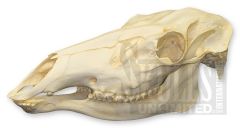
nasal and lacrimal bones separated by prelacrimal vacuity, upper incisors absent, canine incisiform, broad diastema, upper canine present, post orbital bar complete, massive
|
|
|
Odocoileus sp skull
|
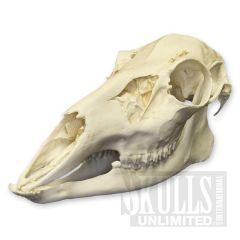
nasal and lacrimal bones separated by prelacrimal vacuity, upper incisors absent, lower canine incisiform, broad diastema, no upper canine, post orbital bar incomplete
|
|
|
Cervus elephus description
|
no dark bands on chin or throat, long brown hairs on neck forming dark mane, conspicuous tawny rump patch,
|
|
|
Odocoileus hemionus
|
no dark band on chin or throat, no mane, white rump patch or none, tail black on dorsal surface or white with a black tip, antlers dichotomously branched
|
|
|
Odocoileus virginianus
|
no dark band on chin or throat, no mane, white rump patch or none, tail light brown on dorsal surface, white on ventral surface, antlers with all tines originating from a main beam
|
|
|
Antilocapra americana description
|
white on chin and throat divided by 2 or 3 darker bands, coarse pelage, dorsum light buff separated sharply from white venter that extends high on the sides, contrasting black and white throat patches, black patch posterior to nose pad, white rump patch
|
|
|
Antilocapra americana skull
|
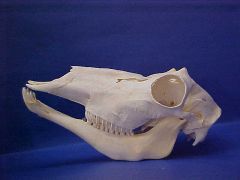
no upper incisors or canines, vacuity between nasal and lacrimal bones, incisiform lower canines, broad diastema, males laterally flattened branched deciduous horn sheath over bony cores permanently attached to frontal bones, some females have cores and horn sheaths
|
|
|
Bos bison description
|
largest artiodactyla, shoulder hump, dark-brown pelage of neck hump and shoulders long and shaggy, short heavy legs, short tufted tail, short curved black horns on males and females
|
|
|
Oreamnos americanus description
|
stocky bovid with black scimitar-shaped horns, large black hooves, entirely white wooly pelage sometimes with scattered brown hairs on dorsum and rump
|
|
|
Ovis canadensis description
|
medium sized, largely browinish bovid with white rump patch muzzle venter and rear portion of legs, horns-males spiral outward -females recurve upward and posteriorly
|
|
|
Ovis canadensis skull
|
acutely triangular, massive spiral horns in males with adaptations for support, recurved horns in females, no upper incisors, lower incisors appressed, lower canines incisiform
|
|
|
soricidae skull characters
|

double pointed incisors, pigmented teeth, pointy unicuspids
|

